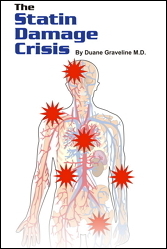Red Yeast Rice and Statins
 By Dr. Duane Graveline, M.D., M.P.H.
By Dr. Duane Graveline, M.D., M.P.H.
Red yeast rice is readily available in the United States as a food supplement and as such it does not fall under FDA guidelines although the FDA has felt obliged to curtail marketing from two manufacturers.
The prevailing opinion about this substance is that since it is natural and uncontrolled it is generally safe to use. This is wrong. The first thing one must understand about red yeast rice is that it is another statin and must be used with understanding.
One can imagine the chagrin of the pharmaceutical industry to discover in a simple yeast from the Orient that Mother Nature already had provided her very own "completely natural" HMG-CoA inhibitor, red yeast rice!
For thousands of years this yeast, known as Monascus purpureus, has been used to ferment rice into wine and as both a spice and preservative. Needless to say, any possible interference of this oriental fermentation product with the emerging statin drug industry was obviated by Merck's patent - the first ever filed on a naturally occurring substance. Mother Nature's statin would never compete with Merck's identical product, lovastatin, which has the trade name of Mevacor.
Red yeast rice has been used in the Orient for over a thousand years. Since 800 A.D. this substance has been employed by the Chinese as both a food and a medicine. Its therapeutic benefits as both a promoter of blood circulation and a digestive stimulant were first noted in the traditional Chinese pharmacopoeia, Ben Cao Gang Mu-Dan Shi Bu Yi, during the Ming Dynasty (1368-1644).
In China, red yeast rice formerly was used to treat abdominal pain due to what they call stagnant blood and dysentery, as well as for both external as well as internal trauma. In addition to its therapeutic applications, red yeast rice has been used for centuries as a flavor enhancer, a food preservative, and a base for a Taiwanese alcoholic rice-wine beverage. In the past decades red yeast rice has been used in China for the same reasons statins are being used in the U.S. and elsewhere for control of cardiovascular diseases.
The traditional method of making red yeast rice is to ferment the yeast naturally on a bed of cooked non-glutinous whole rice kernels. Recently this process has become industrialized. The active components of red yeast rice can vary considerably and the fermentation process demands strict vigilance to insure freedom from toxic impurities.
Red yeast rice contains numerous active constituents, including monacolin K, dihydromonacolin, and monacolin I to VI, all of which have the same HMG-CoA reductase inhibitor effect as modern statins. The only difference is that this product was occured naturally long before the pharmaceutical industry conceived the idea and, allowing for some variations in composition from time to time, may reduce cardiovascular risk much like any of the pharmaceutical statins for it is lovastatin, Merck's generic name for its widely prescribed Mevacor.
When someone takes red yeast rice they are effectively on a statin and subject to all the purported benefits and side effects. I have had reports of side effects from this "natural product" sent to me. Myopathies and even the dreaded rhabdomyolysis have been reported from the use of red yeast rice. The issue is primarily one of dosage or, in some cases, co-administration of over the counter or prescription medications.
Since cholesterol response no longer appears to be a valid end-point in determining statin dose, the entire strategy for dosing all statins must be reviewed. Red yeast rice is another statin with each capsule bearing a dose of statin entirely sufficient for the desired anti-inflammatory response. Ordinarily there will be little or no cholesterol response at this dose, nor do we desire this, for cholesterol is apparently irrelevant to atherosclerosis.
Red yeast rice has been available in 400-600 mg size capsules with manufacturers' recommended beginning dose of 1-2 capsules twice daily. You may see occasional side effects, especially with concurrent administration of erythromycin, grapefruit juice or particularly if you are the recipient of tissue or organ transplant and are taking cyclosporin. This manufacturer's recommended dose is based upon cholesterol response, no longer considered by me to be a valid endpoint of statin effectiveness.
Duane Graveline MD MPH
Former USAF Flight Surgeon
Former NASA Astronaut
Retired Family Doctor
Updated July 2011






